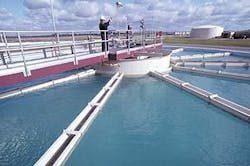Cat-Floc? polymers from eCalgon facilitate coagulation, lower turbidity and form a dense, rapidly settling floc.
Click here to enlarge imageIn the late 1960's, Calgon Corporation patented the chemistry for a high molecular weight polydadmac that performed well with high molecular weights. The product, which they called Cat-Floc, found efficacy in the cosmetic and paper markets, and was even used as a soil stabilizer. Several years later, Calgon introduced a Cat-Floc product designed to work efficiently with low molecular weights. The new formulation was ideal as an organic polymer flocculant in both raw water and wastewater treatment.
The cationic charge of the polymer successfully facilitates coagulation, lowers turbidity and forms a dense, rapidly settling floc. It acts without affecting the pH or alkalinity of the water, which means less caustic is needed to maintain the pH balance of the finished water.
Formulations of the liquid cationic polymer are available today in inorganic or organic blends over a range of molecular weights. Unlike alum, the products will treat raw water consistently regardless of its temperature and require little dosage adjustment over varying raw water turbidities. Consequently, they are popular at plants using a river, reservoir or lake as their water source.
Alum replacement programs are individualized for each plant's specific condition. The cost and dosage of polymer typically needed is determined by the amount of solids and type of particles to be removed and the degree of anionic surface charge which must be neutralized. Up front, Cat-Floc is more expensive than liquid alum, but it is effective in smaller doses. For example, while 5 mg/L to 50 mg/L of liquid alum may be required, a Cat-Floc dose of only .1 mg/L to 5 mg/L may achieve the same result. However, the savings to the customer are not in the cost of the replacement polymer or the dosage, but in its overall effect on the plant's total operating costs.
Operating CostsFacilities that replace some or all of their alum with Cat-Floc see an immediate decrease in their sludge production. For example, one drinking water treatment plant in Hawaii documented a 66 percent reduction in sludge volume after replacing alum in its system, saving more than $15,000 annually in waste disposal alone.
According to Bob Whalen, a District Manager with eCalgon who has been providing Cat-Floc for more than 21 years, the polymer used alone or in combination with alum will enhance filter performance. There are several reasons. First, it allows for deep bed filtration, rather than the typical surface filtration common in most systems treated with alum alone. The floc carryover from the clarifier is captured using the entire depth of the filter, rather than the first few inches from the surface. This facilitates longer filter runs and lowers turbidity.
"Cat-Floc can help increase filter runs 10 to 50 percent, depending on the raw water turbidity and the existing condition of the filter," Whalen said.
The polymer also can be used as a filter aid. In small doses (.05 mg/L to .5 mg/L), it adds a very slight cationic charge to filter media, facilitating the filter to act as a polishing media as well as a filter media, he said.
Since Cat-Floc polymers have no effect on the pH of the treated water, the amount of caustic needed is reduced. A municipal plant in Northern Ohio using Lake Erie as the water source noted that its alum program produced water with typical corrosivity of -16 to -20, requiring an addition of 67 pounds of caustic soda per million gallons for pH adjustment. After adding Cat-Floc to the treatment program, the dosage of caustic was reduced to 25 lb/MG.
Reducing the need for caustic and the ordering and delivery of compounds needed for pH adjustment will reduce labor costs. Also, because the polymer system performs consistently in varying water temperatures, manual adjustments and continuous monitoring of the system are reduced, saving even more in labor costs.
Some plants have realized more than a 100 percent annual return on investment after replacing alum with Cat-Floc. For example, one plant's total annual operating costs for its alum program, including alum, sludge disposal, pH adjustment and flocculator electricity, originally came to $310,000. After switching, the cost of the polymer, reduced sludge disposal, and reduced pH adjustment additives dropped operating costs to $160,000 an ROI of 107 percent.
ConclusionThe alternative coagulant market experienced a boom in the '80s when the water quality standards promulgated by the EPA fostered a need for improved chemistry and water quality. However, the need for efficient polymers is even more critical today, Whalen said.
"At one time, turbidity of 5 ntu was acceptable. Now, typical standards are not to exceed 0.1 ntu," he said. "To meet those standards and others in the future, plants must continuously run at their optimum level." WW/



